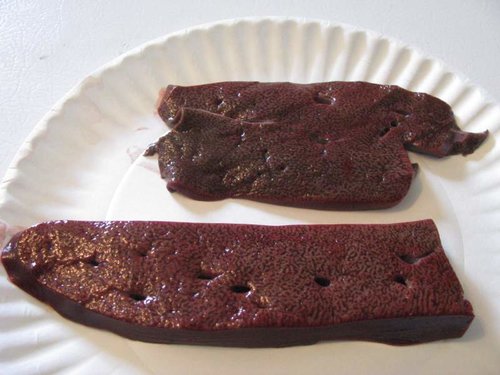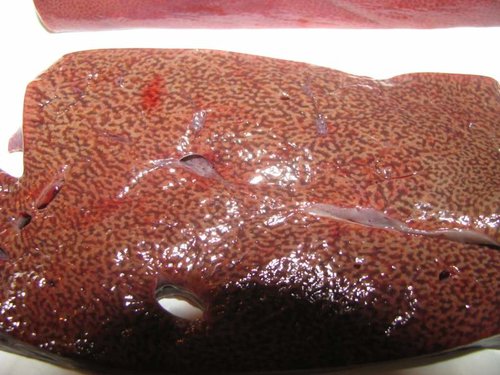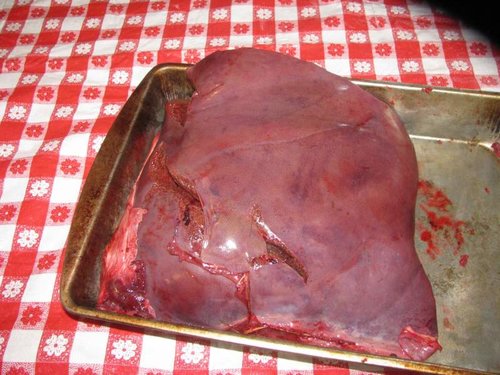Navigation
Install the app
How to install the app on iOS
Follow along with the video below to see how to install our site as a web app on your home screen.
Note: This feature may not be available in some browsers.
More options
You are using an out of date browser. It may not display this or other websites correctly.
You should upgrade or use an alternative browser.
You should upgrade or use an alternative browser.
question for Miller or other bio types
- Thread starter twodot
- Start date
kiwi hunter
Well-known member
- Joined
- Jul 21, 2013
- Messages
- 1,087
dont look healthy to me
Cutting up this elk that we carried out last night. Got to the liver, wife sends up red flag on liver, says it looks "different" to her. Question is, eat it or don't eat it.
Don't eat, according to my wildlife biologist wife. Note she is not a ungulate disease specialist, but that is an abnormal looking liver for sure.
Don't eat, according to my wildlife biologist wife. Note she is not a ungulate disease specialist, but that is an abnormal looking liver for sure.
Actually, if that was my elk I'd probably contact my states vet diagnostic lab or find out who the disease specialist is and get a bit more info on cause.
twodot
New member
DRAFTSTUD
Well-known member
I looked up all the variations of Liver Flukes, Liver with Holes, ect. I think you shot an Elk who drank to Much! John
idnative1948
Well-known member
Geez! Gag a maggot! I have never seem one like that!
Any big lumps on the uncut portion of the liver? My experience with giant liver flukes were large masses with a dark chocolate pudding like consistency inside the lump. I'd consider freezing it and getting it to your local FWP bio or CO. I wouldn't eat it, not that I can come up with any good reason to eat a liver.
L. I. Yankee
New member
I dont eat inners to begin with....that one Id take for a second opinion......
kmf
Member
- Joined
- Aug 23, 2010
- Messages
- 206
I would send it to diagnostics lab at NDSU in Fargo, ND.
twodot
New member
no lumps, holes flukes , nothin. Just didn't look right when cut up in slices as seen in top photo.
Ate meat from backstraps tonight and it was choice.
Do any of you non liver eaters ever slice open your livers in the gutpile to check them out?
Ate meat from backstraps tonight and it was choice.
Do any of you non liver eaters ever slice open your livers in the gutpile to check them out?
bigskyblueman
Member
My understanding was that the liver is the main filter and collection point for toxins in the body. I've had several animals that had livers that didn't look normal , but the meat looked and tasted fine. I do avoid eating liver as a rule.
ismith
Well-known member
Yeah I definitely wouldn't be eating that liver. The elk I shot last month had dark cysts in the fatty tissue that I assume were tape worm cysts or something similar.
pointingdogsrule
Well-known member
The veterinarians son here says "ask a vet". Pointingdogsrule?
I would not eat that liver. Various systemic diseases can cause those changes in the liver. The question is whether the disease process (bacterial, viral, parasitic or metabolic) that caused the change in the liver morphology is still present. That would be unknown unless bacterial, parasitic and viral tests were conducted.
With that stated, I have conducted many necropsies on many Bovines which have a metabolic disease called "Hepatic Lipidosis". Also called "Fatty Liver". It occurs when the animals metabolism is (for simpler terms) disrupted and large amounts of fat are deposited within the liver. That liver looks very similar to fatty deposits within the liver.
I agree with the above statements, in that I would pass on eating the liver. It would be interesting if you could take a sample (unfrozen) to a local DVM and have him preserve it formalin and send it off to the state for histopathology.
Did the animal look healthy in every other aspect?
Good luck to all
the dog
I agree with pointingdog that fatty liver would be a good differential diagnosis. Another condition of unknown etiology that I would throw in there would be sawdust liver. In this pathological condition, there is a leucocytic infiltration which causes a nonsuppurative necrosis. Although the pics are pretty good, it is difficult to differentiate between these pathological conditions. I agree with having histopath done, if you really want to know and I agree with not eating this organ. It is a condemnable condition in a beef slaughter situation.







